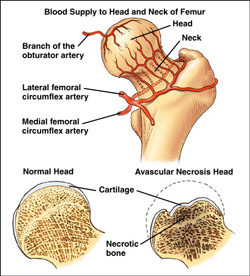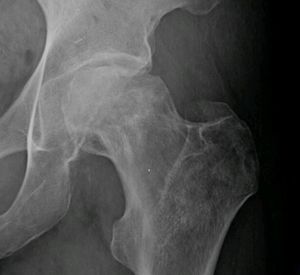We need you! Join our contributor community and become a WikEM editor through our open and transparent promotion process.
Avascular necrosis of hip
From WikEM
Contents
Background
Traumatic and nontraumatic causes can lead to an insult to the blood supply of the joint. The ischemia causes death of osteocytes and bone marrow that leads to necrosis and eventual collapse of the dead segment.

Kupe MD. Hip Fracture. http://drkupe.blogspot.com/2011/03/hip-fracture.html. Accessed July 31, 2016.
Epidemiology
- Estimate of 10,000 to 20,000 new cases per year
- Responsible for about 10% of all total hip replacements
- Patients typically diagnosed before 40 years of age
Etiologies[1]
Traumatic causes
Non-traumatic causes
- Use of corticosteroids, alcohol, tobacco
- Systemic lupus erythematosus
- Sickle cell disease
- Chronic Kidney Disease
- Pancreatitis
- Radiation therapy
- HIV
- Caisson Disease (aka Dysbarism)
- Legg-Calve-Perthes disease
- Idiopathic
Clinical Features
- Limp
- Limited range of motion of joint, both active and passive
- Pain: Knee, Thigh, and/or Groin
- Wasting of local musculature
- Asymmetric leg length
Differential Diagnosis
Hip pain
- Femur fracture
- Hip dislocation
- Hip bursitis
- Psoas abscess
- Piriformis syndrome
- Meralgia paresthetica
- Septic Arthritis (Hip)
- Obturator nerve entrapment
- Pelvic fractures
- Avascular necrosis of hip
Evaluation
- Plain XR is poorly sensitive in early stages, as low as 41%
- AP and Frog leg views
- MRI ~90% sensitivity and specificity
- Best test
- Bone Scan (aka Bone Scintigraph)
- May show evidence of early bone ischemia
Management
- Nonsurgical
- Considered ineffective at stopping progression of ischemia
- Bedrest, limit weightbearing, pain control
- Medications
- Bisphophonates, vasodilators, and anticoagulants have been used but efficacy has not yet been proven
- Surgical
- Total Join Replacement
- Unfortunately, patients with osteonecrosis have an increased failure rate of the procedure.
- Ongoing research for treatment
- Joint preserving operations, Bone marrow decompression therapy, vascularized and nonvascularized bone grafts, Bone marrow grafting, and Osteotomy
Disposition
It is vital to order medical and orthopedic referrals for evaluation of comorbidities and evaluation of joint in the emergency department.
- Progression to subchondral collapse if the diagnosis is missed and untreated
- 67% in asymptomatic patients
- Greater than 85% in symptomatic patients
- In one study by the American Academy of Orthopaedic Surgeons, early detection and treatment with core decompression has shown to prevent the need for total hip replacement.
See Also
References
- ↑ *JONES PHD, L. C. AND MONT MD, M. A. Osteonecrosis (avascular necrosis of bone) In-text: (Jones PhD and Mont MD) Your Bibliography: Jones PhD, Lynne C and Michael A Mont MD. "Osteonecrosis (Avascular Necrosis Of Bone)". UpToDate. N.p., 2016. Web. 31 July 2016.
- Kelly JD et al. Femoral head avascular necrosis treatment & management. Aug 16, 2015. http://emedicine.medscape.com/article/86568-treatment#showall.
- Miller MD M, Fisher MD S, Foran J. Osteonecrosis of the Hip. American Academy of Orthopaedic Surgeons. http://orthoinfo.aaos.org/topic.cfm?topic=a00216. Accessed August 2, 2016.
- Stoica Z et al. Imaging of Avascular Necrosis of Femoral Head: Familiar Methods and Newer Trends. Curr Health Sci J. 2009 Jan-Mar; 35(1): 23–28.
- Wainwright A. Legg-Calve-Perthes disease diagnostic tests - Epocrates online. Epocrates. https://online.epocrates.com/diseases/75134/Legg-Calve-Perthes-disease/Diagnostic-Tests. Accessed July 31, 2016.


